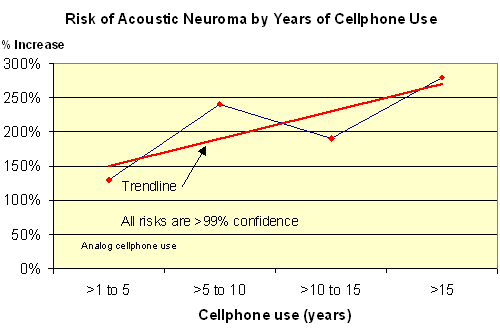 |
 |
|
 |
 |
About Us | Contact |
|
|
Lloyd Morgan's ColumnCommentary on a Study of the Risk of Brain Tumors from Cellular and Cordless Phone UseHardell et al., Pooled analysis of two case-control studies on the use of
cellular and cordless telephone and the risk of benign brain tumours during
1997-2003;
| ||||||||||||||||||||||||||||||||||
| Phone Type | Acoustic Neuroma | Meningioma | ||
| Risk | % Confidence | Risk | % Confidence | |
| Analog + digital cellphones | 3.3 | 99.99990% | 1.3 | 87% |
| Analog cellphones + cordless phones | 3.9 | 99.999998% | 1.7 | 99.6% |
| Digital cellphones + cordless phones | 1.6 | 97.5% | 1.2 | 80% |
| Analog + digital cellphones + cordless phones | 4.1 | 99.99994% | 1.7 | 98.6% |
| Any combination | 1.5 | 99.3% | 1.5 | 99.3% |
Bold indicates a statistically significant risk (>95% confidence).
Of particular interest is that the authors report - the only study to do so to date - risk of acoustic neuroma for > 10-15 years (risk = 2.9, 99.7% confidence) and for > 15 years (risk = 3.8, 99.3% confidence). The graph below shows the percentage of increased risk of acoustic neuromas by years of cellphone use.

Unlike the Interphone series of cellphone studies, which had a large proportion of controls who refused to participate in the study, this study had nearly identical participation rates between cases (87.8%) and controls (88.7%). Such high and similar participation rates minimize problems that can cause an underestimation of risk.
In contrast, the Interphone series of studies on the risk of brain tumors from cellphone use has consistently had poor participation rates. For example, a recently published UK Interphone study had participation rates of 51% for glioma cases (30% had died by the time they were contacted) and 45% for the participating controls (29% refused to participate). [1]
As mentioned, the problem with poor participation rates is that selection bias is likely to cause an underestimation of risk. In the UK study, with 30% of the glioma cases dying before they were able to participate, the effect was to strongly underestimate the risk of high-grade glioma from cellphone use. Similarly, with only 45% of the controls participating there is a strong likelihood of a selection bias problem that would underestimate the risk of brain tumors from cellphone use. Such selection bias would result if the participating controls used cellphones more frequently than non-participating controls.
References
[1] Hepworth et al., Mobile phone use and risk of glioma in adults:
case-control study;
British Medical Journal, 19 January 2006
http://bmj.bmjjournals.com/cgi/content/abstract/bmj.38720.687975.55v1

